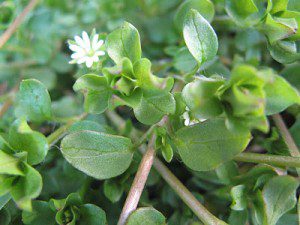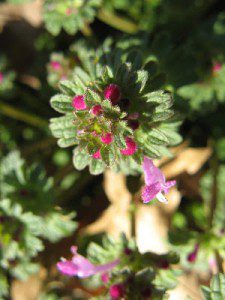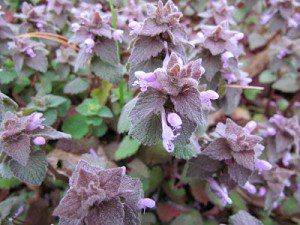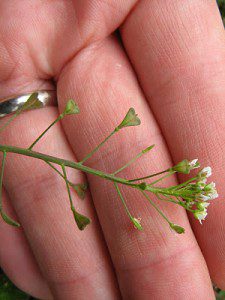

Even if you didn’t intend to grow a nurse crop when you planted your winter small grain, you might find that you have, especially if you planted early. The neat rows of triticale, barley, oats, or wheat may be sheltering new growth of chickweed and henbit, winter annual weeds that like to start growing in cool, shady conditions and look low-growing and non-threatening right now. As they grow slowly over the winter, the taller growth of the grain crop provides its companion weed with insulation against cold and frost. A blanket of snow over the grass canopy helps provide further insulation. Then in the spring, they take off and grow more rapidly and bloom as the weather warms. They tend to produce seed around the time that your small grain crop is heading.
We sometimes get questions about whether these weeds make good forage, since they are often cut and processed along with the main forage crop. The quality is likely quite high, but they are so succulent and tender that they give very little dry matter, while robbing your main crop of moisture, nutrients, and sometimes sunlight, depending on the growth habit of the weed.
The winter annual weed issue is often a matter of timing. An earlier planting of the small grain is good for fall growth and earlier tillering, but it also means spraying earlier. The earlier you spray herbicide, the fewer winter annual weeds you’ve killed prior to the new crop, and the more that will appear in between the rows of the small grain. Luckily, most of these weeds are broadleaves and will respond to a broadleaf herbicide, while the grass crop is left unharmed. Watch out for safe windows, though. For example, it is only safe to spray 2,4-D in a wheat crop after full tillering but before jointing.
According to UMass Extension, “Fall applications of herbicides are sometimes used to control winter annuals. Because of the long emergence period of winter annuals, however, these applications are rarely 100% successful. Preemergence herbicides often disappear from the soil before winter annual weeds have finished emerging.” A later planting likely means that you catch more of the weeds with the herbicide, but there can also be much growth to gain from an earlier planting as well, so it’s a balancing act.

Weeds usually pose the most threat in the crop that matches its lifecycle, and preparing the ideal seedbed for the crop creates an ideal seedbed for the weed, as well. Annual weeds are best adapted to growing in annual crops. In a pasture situation, mowing is a good way to control annual weeds.
Chickweed, henbit, and deadnettle are common winter annual weeds we are starting to see in Lancaster County, PA. Chickweed has a shallow, fibrous root and does well in moist, cool, shaded areas. It reproduces both by seed and rooting of prostrate stems at the nodes. The seeds can germinate at any time of year, but mostly in the spring and fall. Henbit and deadnettle are both in the mint family and have the characteristic square stems. Deadnettle is often purple or red, and flowers appear from March to May. It is readily controlled by tillage in the late fall or early spring.
It might go without saying, but most of these weeds are more easily controlled at early growth stages than later. As they mature, they either need more herbicide or different herbicides.
Even if you want a fairly early planting of the small grain, it is best to wait for a weed flush and then use your weed control method of choice, whether it is herbicide, tillage or

both.
If you are not planting a small grain, a quick-growing cover crop that forms a dense canopy, such as daikon radish, or a mix of broadleaves, legumes and grasses (such as our Broadcaster and Cargo mixes), is useful in smothering winter annual weeds.
It’s best in any case to control the weed by early spring, when it begins actively growing and taking up nitrogen, stealing it from the following crop.
Speak to an expert at King’s AgriSeeds now at 1-717-687-6224 or email us at [email protected].
